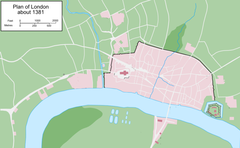
Back Savoy-paleis Afrikaans Savoy Palace German Palacio Savoy Spanish Hôtel de Savoie French ארמון סבוי HE Savoy Palace Italian サヴォイ・パレス Japanese 사보이궁 Korean Savoy Palace NN Savoy Palace NB
| Savoy Palace | |
|---|---|
 1848 engraving by Charles Thurston Thompson | |
| General information | |
| Type | townhouse |
| Architectural style | Norman |
| Location | Liberty of the Savoy, Middlesex |
| Country | England |
| Coordinates | 51°30′38″N 0°7′13″W / 51.51056°N 0.12028°W |
| Named for | Peter II, Count of Savoy |
| Destroyed | 1381 |
| Owner | Peter II, Count of Savoy Edmund Crouchback Thomas, 2nd Earl of Lancaster Henry, 3rd Earl of Lancaster Henry of Grosmont, 1st Duke of Lancaster John of Gaunt |
| References | |
| https://www.duchyoflancaster.co.uk/properties-and-estates/the-urban-survey/ | |
The Savoy Palace, considered the grandest nobleman's townhouse of medieval London, was the residence of prince John of Gaunt until it was destroyed during rioting in the Peasants' Revolt of 1381. The palace was on the site of an estate given to Peter II, Count of Savoy, in the mid-13th century, which in the following century came to be controlled by Gaunt's family and then the monarch by right of the Duchy of Lancaster. `It was situated between the Strand and the River Thames. French monarch John II of France died here during his "honourable captivity", after an illness. In the locality of the palace, the administration of law was by a special jurisdiction, separate from the rest of the county of Middlesex, known as the Liberty of the Savoy.
The Tudor-era Savoy Chapel is located on the site of the former palace and has carried on the name. The name is also carried on by the Savoy Theatre and Savoy Hotel also located on the former estate.

